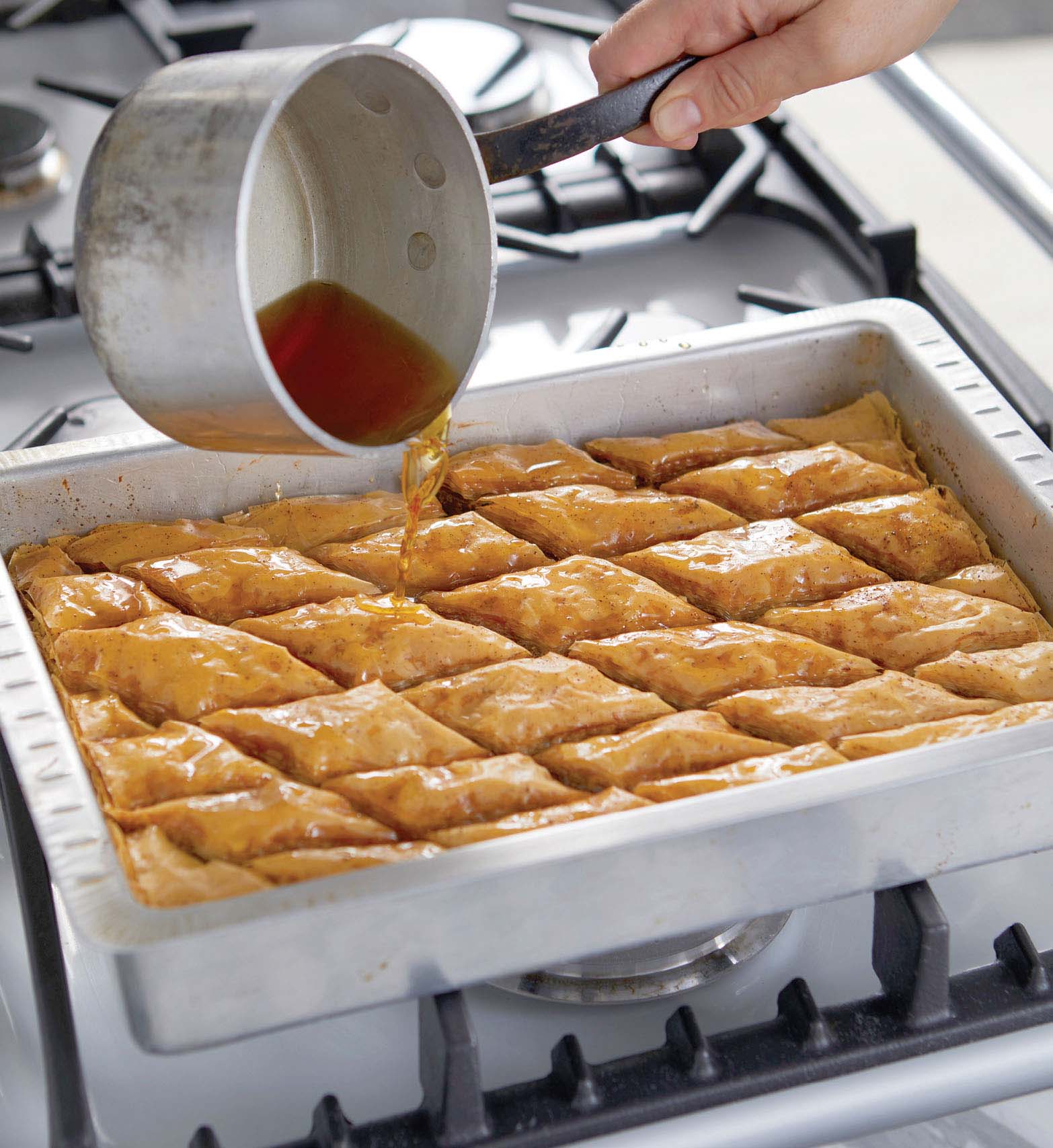CANDY BAR BAKLAVA
Makes about 2½ dozen pieces
RIGHT OFF THE TOP, LET ME SAY THIS RECIPE IS A TOTAL ABOMINATION TO MY Greek ancestry, I’m certain of that. But in my defense, I’m only, like, one-eighth Greek. So, basically what that means is I’m just Greek enough that adorable, rotund old Greek men approach me in random places with their hairy forearms, chunky gold rings, and Old Spice-d collars, silently look at my face with slightly narrowed eyes for a solid six seconds, and then ask me what my last name is (it’s actually my mother’s maiden name—Foropoulos—which becomes the big revelation in these conversations). But I’m not so Greek that I can’t do ridiculous things like bastardize baklava in dangerously Pinteresting ways.
The roots of baklava, or baklawa, run deep in the Midwest. Not only is there a rich history of Greek immigrants, especially in urban areas—by 1920, one of every three restaurants in Chicago was operated by a Greek—but there’s also a wonderfully strong representation of the Middle East throughout the region, and the pastry shops prove it. Such as in Dearborn, Michigan, home of the nation’s largest Arab American population and the famous Shatila Bakery. It turns out legendary baklawa in different varieties that will inspire you to put your own twist on the classic, like this one.
Nonstick cooking spray for pan
LAYERS:
10 tablespoons/140 g unsalted butter
¼ teaspoon plus ⅛ teaspoon fine sea salt, divided
1 cup/300 g chocolate hazelnut spread
1 (16-ounce/453 g) box phyllo dough*
3½ cups/420 g salted cocktail-style peanuts, very finely chopped*
SYRUP:
1¼ cups/281 g lukewarm water, divided
1 cup/200 g granulated sugar
1 tablespoon honey
¼ teaspoon fine sea salt
½ teaspoon pure vanilla extract
Position a rack to the center of the oven and preheat it to 350°F/180°C. Spray a 9 × 13-inch/23 × 33 cm light-colored metal baking pan with nonstick cooking spray.
Prepare the layers: In a 1- to 1½-quart/1 to 1.4 L saucepan, combine the butter and ¼ teaspoon of the salt. Brown the butter (see here). Pour into a clean bowl and set aside to cool.
In a small, microwave-safe bowl, combine the chocolate hazelnut spread and remaining 1/8 teaspoon of salt. Heat in a microwave for about 30 seconds on HIGH, or until somewhat fluid.
Get your layering station ready: Unroll the phyllo pastry into a stack on a work surface (if your phyllo comes in a box with 2 rolls, unwrap only 1 roll to start, and unwrap the other as you need it). If the dimensions of the phyllo sheets are larger than your pan, use kitchen scissors to trim the stack of phyllo so the sheets will fit neatly. Wet a tea towel and wring it out until it’s just damp. Place the towel over the pastry to keep it from drying out. Have your bowls of browned butter, warm chocolate hazelnut spread, and a pastry brush at the ready.
Start the layering: Place 2 sheets of phyllo in the bottom of the prepared pan. Lightly brush with browned butter. Add 2 more sheets and butter them. Repeat 3 more times until you have 10 sheets in total. Sprinkle with one third of the peanuts, and drizzle ⅓ cup of chocolate hazelnut spread on top. Place 2 more sheets of phyllo on top and butter them. Repeat 2 more times for a total of 6 new sheets. Add half of the remaining peanuts and ⅓ cup more chocolate hazelnut spread.
Layer with another 6 sheets, buttering every 2 sheets. Add the remaining peanuts and chocolate hazelnut spread (if either the browned butter and/or chocolate begins to solidify, microwave for 10 to 15 seconds). Add 6 more sheets of phyllo, buttering every other sheet. For the last 4 sheets at the top, butter between every single sheet, and the very top.
Using a thin, sharp knife, cut the baklava into diamond-shaped portions, slicing all the way through to the bottom of the pan. Start with 3 straight cuts evenly spaced down the length of the pan. Then, make 8 or 9 diagonal cuts across the pan, evenly spacing them.
Bake until golden and crisp, about 45 minutes.
During the final 10 minutes of baking, prepare the syrup: Pour ¼ cup/57 g of the lukewarm water into a 1- to 1½-quart/1 to 1.4 L saucepan. Gently pour the sugar over the water in an even layer. Add the honey and salt. Place the pan over medium heat and stir slowly in a figure-eight motion to help the sugar dissolve while the mixture heats up. Once the syrup is nearly clear, increase the heat to high and stop stirring. Boil, swirling the pan occasionally, until the sugar caramelizes and turns a deep amber with a few wisps of smoke, 7 to 8 minutes total.
Briefly remove the pan from the heat and carefully pour in the remaining 1 cup/225 g of lukewarm water. Swirl the pan to incorporate the water into the caramel. Place the pan back over high heat and boil to a thin syrup, reducing it to about 1¼ cups/285 ml, about 5 minutes.
When the pastry has finished its 45-minute bake, transfer the pan to a wire rack to cool for 10 minutes. Leave the oven on! As soon as the syrup has finished reducing, whisk in the vanilla, then slowly drizzle the hot syrup over the still-hot pastry. Return the pastry to the oven to bake for 5 more minutes. Let cool completely in the pan set on a wire rack and rest at room temperature for at least 4 hours before serving.

*You’ll need 40 sheets of phyllo for this recipe.
*You want a mixture of nearly ground and pebbly lentil-size pieces. A food processor is the easiest way to do this, with about 25 pulses.